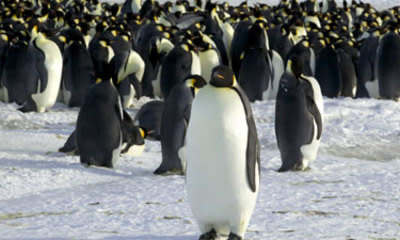Satellites Used To Track Penguins From Space

Counting penguins in the Antarctic wastes of their homeland was a difficult task for researchers, until they used new technology to map the birds from space.
For three years, an international team of scientists used satellite mapping with resolution high enough to distinguish ice shadows from penguin faeces.
And they discovered some good news - the Antarctic emperor penguin population was nearly twice as large as previously thought, numbering about 595,000.
However, they also found that some colonies have disappeared due to changing weather patterns and that the long-term future of the birds is far from assured.
Barbara Wienecke, a sea bird ecologist with the Australian Antarctic Division , said: "This is the first comprehensive census of a species taken from space, absolutely."
Previous counts have been inaccurate due to rough terrain that made some colonies inaccessible and frigid temperatures that can plummet to -50C.
This time the group used aerial photography to calibrate their analysis of counts taken on the ground.
The researchers found that emperor penguins, with their distinctive black and white plumage, stand out against the snow and are visible on satellite images.
The technique also has the advantage of having no negative impact on the sensitive Antarctic environment or the birds.
Previous censuses using more traditional counting methods came up with much lower estimates of 270,000 to 350,000 birds.
Although the higher number is encouraging, changing weather patterns pose a risk to the species' survival.
The larger population may also put pressure on the numbers of krill in the oceans, which is their essential food.
Warming oceans observed by the research team can also have an impact.
"Long fast ice" - ice that is attached to the continent and forms a continuous flat area of frozen ocean - is a particular worry.
This is where most of the penguin colonies are found because its flat surface is essential for male penguins who incubate each mating pair's single egg on their feet.
"Things change very quickly, so we can't take comfort in having half a million birds at the moment," Ms Wienecke said.
"If the fast ice changes, the birds can end up in a lot of strife very, very quickly."

 Yahoo News
Yahoo News 